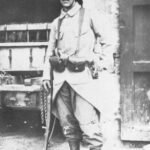
Alan Seeger (22 June 1888 – 4 July 1916) was an American war poet who fought and died in World War I during the Battle of the Somme, serving in the French Foreign Legion.
I have a rendezvous with Death
At some disputed barricade,
When Spring comes back with rustling shade
And apple-blossoms fill the air—
I have a rendezvous with Death
When Spring brings back blue days and fair.
It may be he shall take my hand
And lead me into his dark land
And close my eyes and quench my breath—
It may be I shall pass him still.
I have a rendezvous with Death
On some scarred slope of battered hill,
When Spring comes round again this year
And the first meadow-flowers appear.
God knows ’twere better to be deep
Pillowed in silk and scented down,
Where Love throbs out in blissful sleep,
Pulse nigh to pulse, and breath to breath,
Where hushed awakenings are dear …
But I’ve a rendezvous with Death
At midnight in some flaming town,
When Spring trips north again this year,
And I to my pledged word am true,
I shall not fail that rendezvous.
Seeger was the brother of Elizabeth Seeger, a children’s author and educator, and Charles Seeger, a noted American pacifist and musicologist; he was also the uncle of folk musicians Pete Seeger, Peggy Seeger, and Mike Seeger. He is lauded for the poem “I Have a Rendezvous with Death”, a favorite of President John F. Kennedy.
A statue representing him is on the monument in the Place des États-Unis, Paris, honouring those American citizens who volunteered to fight for the Third French Republic while their country was still neutral and lost their lives during the war. Seeger is sometimes called the “American Rupert Brooke”.










Leave a Reply